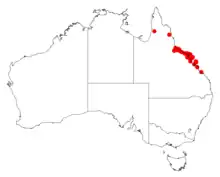| Acacia spirorbis | |
|---|---|
 | |
| Scientific classification | |
| Kingdom: | Plantae |
| Clade: | Tracheophytes |
| Clade: | Angiosperms |
| Clade: | Eudicots |
| Clade: | Rosids |
| Order: | Fabales |
| Family: | Fabaceae |
| Subfamily: | Caesalpinioideae |
| Clade: | Mimosoid clade |
| Genus: | Acacia |
| Species: | A. spirorbis |
| Binomial name | |
| Acacia spirorbis | |
 | |
| Occurrence data from AVH | |
Acacia spirorbis is a tree belonging to the genus Acacia and the subgenus Juliflorae that is native to eastern Australia.
Description
The tree typically grows to a maximum height of 12 m (39 ft) and has slender, glabrous branchlets.[1] Like most species of Acacia it has phyllodes rather than true leaves. The glabrous and dark green coloured phyllodes have a narrowly elliptic shaped and recurved to a sickle shape. They are 9 to 17 cm (3.5 to 6.7 in) in length and have a width of 6 to 16 mm (0.24 to 0.63 in) with two main longitudinal veins that have greater prominence than the others. When it blooms it produces simple inflorescences that occur in pairs in the axils. The cylindrical flower-spikes have a length of 3 to 8 cm (1.2 to 3.1 in) with creamy coloured flowers that occur in interrupted bands. Following flowering flat and spirally coiled seed pods form that have a width of 3.5 to 5 mm (0.14 to 0.20 in) are glabrous and covered in a fine white powder. The seeds inside the pods are arranged longitudinally or slightly obliquely. The shiny dark brown seeds have an oblong shape with a bright yellow aril that is folded many times under the seed.[1]
Taxonomy
The species was first formally described by the botanist Jacques Labillardière in 1825 as part of the work Sertum austro-caledonicum. It was reclassified by Leslie Pedley in 1987 as Racosperma spirorbis and then transferred back to genus Acacia in 2006.[2]
There are two subspecies:
- Acacia spirorbis subsp. spirorbis
- Acacia spirorbis subsp. solandri
Distribution
It is endemic to the coastal parts of Queensland extending from Townsville in the north down to around MacKay in the south including numerous islands off the coast and a smaller isolated population on Rat Island further south near Rockhampton. The tree is usually situated along the margins of rainforest communities or as a part of Eucalyptus woodlands in drier areas.[1] It is also native to Vanuatu and New Caledonia.[3]
See also
References
- 1 2 3 "Acacia spirorbis". WorldWideWattle. Western Australian Herbarium. Retrieved 7 February 2020.
- ↑ "Acacia spirorbis Labill". Atlas of Living Australia. Global Biodiversity Information Facility. Retrieved 8 February 2020.
- ↑ "Acacia spirorbis". Global Plants. JSTOR. Retrieved 8 February 2020.